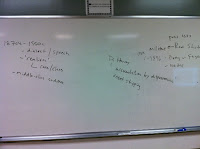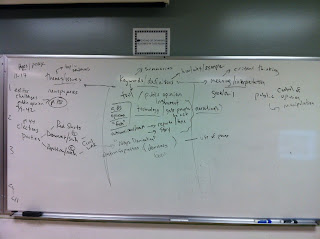
 Last week we hovered in the first few decades of the 20th century, and examined race riots and the Great Depression. To do this we looked through the lens of two novels: Nathaniel West's The Day of the Locust and David Bryant Thorne's Hanover, Or the Persecution of the Lowly. In both novels, we see an intersection between collective violence, collective resentment, and collective aggression against bodies that are simultaneously symbolic and objective targets of that violence.
Last week we hovered in the first few decades of the 20th century, and examined race riots and the Great Depression. To do this we looked through the lens of two novels: Nathaniel West's The Day of the Locust and David Bryant Thorne's Hanover, Or the Persecution of the Lowly. In both novels, we see an intersection between collective violence, collective resentment, and collective aggression against bodies that are simultaneously symbolic and objective targets of that violence.When we watched the final scene of John Schlesinger's 1975 vision of The Day of the Locust, for example, we clearly see the way the enraged crowd gathered for a Hollywood film premiere quickly turns on the very symbols and bodies of its affection. Once the destruction begins, the symbols of wealth, status, and power immediately become targets for resentment, frustration, and rage. This occurs even as the crowd turns on itself, particularly in form of older men devouring young children. The crowd eats its young - just as Hollywood exploits crowds through it's "dream dump" of historical and romantic fantasies. American life was so many groups and classes feeding off one another; The Day of the Locust, I argued somewhat playfully, is the first zombie text.

 Later in the week, we returned to earlier moments of the 20th century in order to revisit another form of racial violence that emerged out of white supremacy and American nationalism (besides lynching): the race riot. Like lynching, race riots involved some narrative of sexual violation between white and black communities. Furthermore, the overwhelming majority of those sexual violation narratives were produced, circulated, and sustained by the authority of newspapers. In the case of Hanover, we find that the entire riot of Wilmington, North Carolina was planned by local Democrats in order to return to power. They used the newspaper as an agent instigation and accusation, but the execution involved to overthrow black and Republican government took months to organize and involved several different kinds of figures in the white community. We conversed about how elite members of the white community were able to mobilize lower-class whites as a militant "Red Shirt" organization through narratives of sexual violation, but also through promises of material gain.
Later in the week, we returned to earlier moments of the 20th century in order to revisit another form of racial violence that emerged out of white supremacy and American nationalism (besides lynching): the race riot. Like lynching, race riots involved some narrative of sexual violation between white and black communities. Furthermore, the overwhelming majority of those sexual violation narratives were produced, circulated, and sustained by the authority of newspapers. In the case of Hanover, we find that the entire riot of Wilmington, North Carolina was planned by local Democrats in order to return to power. They used the newspaper as an agent instigation and accusation, but the execution involved to overthrow black and Republican government took months to organize and involved several different kinds of figures in the white community. We conversed about how elite members of the white community were able to mobilize lower-class whites as a militant "Red Shirt" organization through narratives of sexual violation, but also through promises of material gain.As in later race riots in Atlanta and Tulsa, the Wilmington riot coalesced white civic passions around the threat of black masculinity, but we cannot explain the riot without understanding how certain members of the crowd stood to gain from its activities. In order to understand the anatomy of the crowd, then, we have to locate how it's formed and how it acts according to a certain logic. It's not a simple "destruction," as Le Bon might put it, but a focused violence that reconfigures local political and economic order for the gain of particular members of the community. Everyone stands something to gain, but each gains something different: the Democrat leaders re-assume power and re-assign black jobs to favored white persons; opportunistic or organized members of the white community can take over black homes and businesses, and thus appropriate wealth and status; and exploited members of the white community can assign blame and punish others for their condition in life, without having to blame themselves or, somewhat impossibly, members of the white elite. Taken together, these actions are more economically and politically strategic than abjectly destructive. The economist David Harvey calls these moments of organized mass theft "accumulation by dispossession."



No comments:
Post a Comment